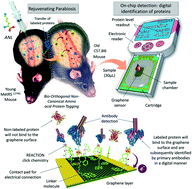Graphene-based biosensor for on-chip detection of bio-orthogonally labeled proteins to identify the circulating biomarkers of aging during heterochronic parabiosis†
Abstract
Studies of heterochronic parabiosis, where two animals of different ages are joined surgically, provided proof-of-principle results that systemic proteins have broad age-specific effects on tissue health and repair. In an effort to identify these systemic proteins, we previously developed a method to selectively label the proteome of only one animal joined in parabiosis utilizing bio-orthogonal non-canonical amino acid tagging (BONCAT), which can metabolically label proteins during their de novo synthesis by incorporating a methionine substitute, azido-nor-leucine (ANL), in cells expressing a mutant methionyl-tRNA synthetase (MetRSL274G). Once labeled, we can selectively identify the proteins produced by the MetRSL274G transgenic mouse in the setting of heterochronic parabiosis. This approach enabled the detection of several rejuvenating protein candidates from the young parabiont, which were transferred to the old mammalian tissue through their shared circulation. Although BONCAT is a very powerful technology, the challenges associated with its complexity including large starting material requirements and cost of ANL-labeled protein detection, such as modified antibody arrays and mass spectrometry, limit its application. Herein, we propose a lab-on-a-chip technology, termed Click-A+Chip for facile and rapid digital detection of ANL-labeled proteomes present in minute amount of sample, to replace conventional assays. Click-A+Chip is a graphene-based field effect biosensor (gFEB) which utilizes novel on-chip click-chemistry to specifically bind to ANL-labeled biomolecules. In this study, Click-A+Chip is utilized for the capture of ANL-labeled proteins transferred from young to old parabiotic mouse partners. Moreover, we were able to identify the young-derived ANL-labeled Lif-1 and leptin in parabiotic systemic milieu, confirming previous data as well as providing novel findings on the relative levels of these factors in young versus old parabionts. Summarily, our results demonstrate that Click-A+Chip can be used for rapid detection and identification of ANL-labeled proteins, significantly reducing the sample size, complexity, cost and time associated with BONCAT analysis.

- This article is part of the themed collection: Lab on a Chip Emerging Investigators


 Please wait while we load your content...
Please wait while we load your content...